Earlier this month, I took a trip to Salar de Uyuni with three Bolivian friends. At a whopping 12,106 square km (3653m above sea level), the Salar is the world`s largest salt flat and contains more than half the world`s supply of lithium. It is estimated that 20,000 tons of salt are extracted and processed each year, for sale in Bolivia as well as international export.
Lonely Planet describes the twelve hour ($14/£9) bus ride from La Paz as `bone-shaking` and it was no exaggeration. The final third of the journey was over dirt road which proved to be a rude awakening at 4am. Picture the roughest aeroplane landing you have ever experienced (sans seatbelt) and then imagine it lasting for four solid hours. Suffice to say, I emerged bleary-eyed and more than mildly grumpy after two such overnight journeys (especially on the way back when my window was scotch-taped together and rattling incessantly). The only upside of the turbulent ride was being awake to witness the sunrise, the sky slowly turning pink as our double-decker bus barrelled through the desert.
Uyuni itself is a fairly uninspiring town, with tour agencies, pizzerias and little else. Just outside the town is an ancient train cemetery, an eerie and desolate place where the wind whips around rusted shells of abandoned trains dating back to the 19th century.
Visiting the Salar requires an organized tour, and unfortunately guide books and the internet are rife with horror stories about drunk-drivers, poorly maintained vehicles and accidents, claiming `it is impossible to recommend operators with any confidence`. Perfecto. Dubious agencies reputedly squeeze up to seven people into their jeeps – gas canisters, food and rucksacks strapped to the tops of the vehicles – with little regard for either safety or the environment. Fortunately one of our group works for a travel agency and had a somewhat reliable contact, and I was instructed to stay quiet (and pretend to be half-Bolivian, if anyone asked) as my friends negotiated a private, made-to-measure tour for the four of us at a `national` price.
We set off with our guide and driver, José, and his 9 year old son, also José. I waited until we were sufficiently far into the wilderness before attempting to make conversation, thus revealing my non-Bolivian identity. José senior was a man of few words, but a taciturn driver was preferable to a drunk one, and he admirably doubled as a mechanic when our jeep broke down on day two.
It is difficult to describe just how stunning the scenery is, nor do my photos do the landscape justice. It felt as though we were crossing through different planets, as we sped across the vast white expanse of salt and bounced our way through the desert. At times bleak and eerie, the desolate desert plains stretched for miles, turning from arid cactus-laden hills to rust red sand. Volcanoes tower above the sands, some of them active, while Andean peaks as far as Chile are visible in the distance.
Herds of llama and vicuña (a wild relative of the llama) graze in the brush, scattering as jeeps approach. As we lurched along, I was lucky to spot two rare rheas – Bolivia`s version of the ostrich – bounding through the dusty plains with their feathered middles fluttering like tutus. Everyone but the driver was asleep and we were moving too fast for a photo, so it was a surreal moment that I half-wondered if I`d imagined (I was heartened when I later Googled ‘ostriches in Bolivia’).
We stopped at various lagunas, where flocks of flamingoes gather to feed on minerals in icy, rose-coloured water. After a lunch of llama steaks, we piled back into the jeep to visit surreal rock formations and geysers, spouting clouds of sulphuric-smelling steam from their depths. José senior broke his silence to make a wry comment that the odd feckless tourist has been known to slip and fall to their death in the geysers while posing for photos. (I chose to believe him, though that particular Google search came up empty).
Salt hotels have sprung up to accommodate visiting tourists, but we stayed in cheaper, basic accommodation (beds of stone rather than salt) in the middle of the desert. The weather is extreme in the Salar, switching from burning hot during the day to freezing cold at night. Breakfast was served at 5am, and we set off on the long and bumpy ride back to the Salar, with a brief mechanical failure and lunch at an island that looked like a pincushion of cactuses.
One week prior to our trip, a group of five Australian tourists and their guide became lost in the Salar for five days before being found safe and sound. Since returning two weeks ago, two more groups have survived being missing for several days. Rain obliterates the trails of other vehicles and plays havoc with visibility, and in these vast salt flats, an inexperienced guide can easily become disoriented. Guides rely upon the distant volcanoes as navigational markers, but when heavy rains strike, there is nothing to be done but come to a standstill and wait.
The salt makes for a blinding surface, akin to driving across an enormous mirror. It is a breath-taking, brilliant white expanse that seems to be endless. At some points the surface is slick and smooth, at others there are cone-shaped mounds of extracted salt, and yet further, hexagonal salt tiles spread as far as the eye can see. We had fun taking some obligatory cliched perspective shots and later watched the Josés demonstrate salt extraction with a hammer, locating cracks in the tiles that conceal deep, salty pools. After chiselling and banging away, they unearthed glistening mounds of crystallised salt.
This post is coming a little late since I`ve been busy with work, travelling to attend FONCRESOL`s three day AGM (where I presented to the five regional offices, causing a predictably disproportionate amount of anxiety). The meeting took place seven hours away, just outside Cochabamba, a city renowned for its abundance of food (five hearty meals a day) and whose inhabitants possess possibly the greatest name ever: Cochabambinos.
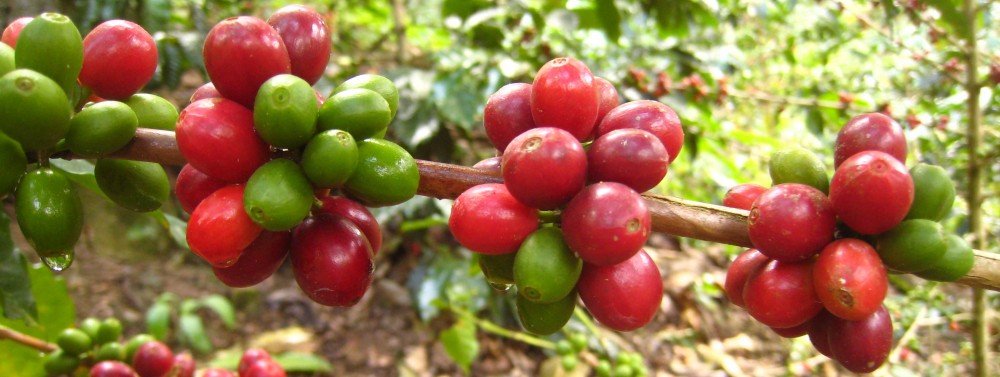
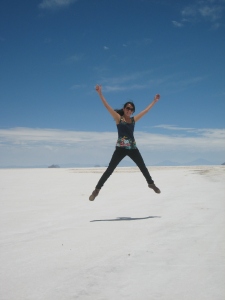
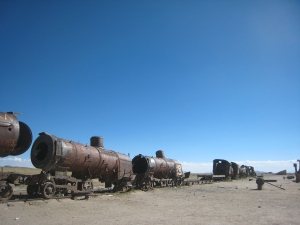
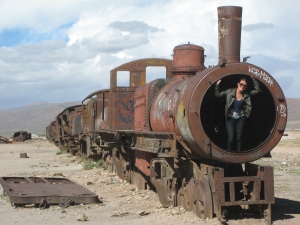
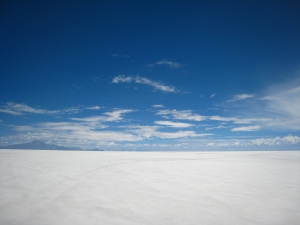
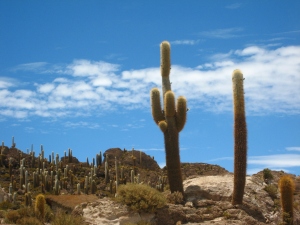
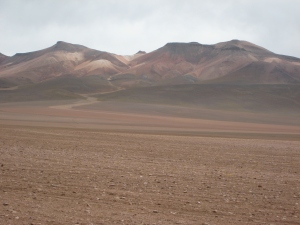
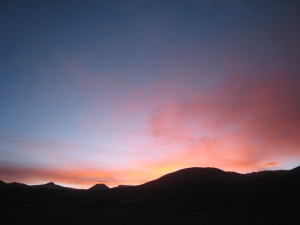
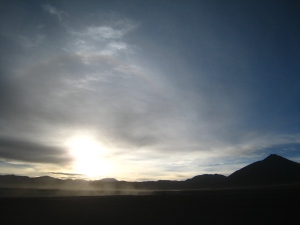
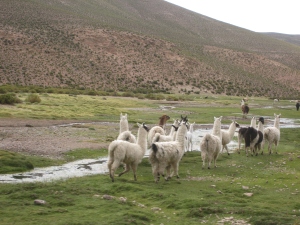
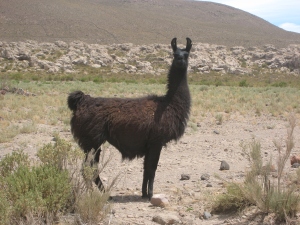
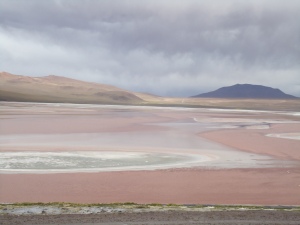
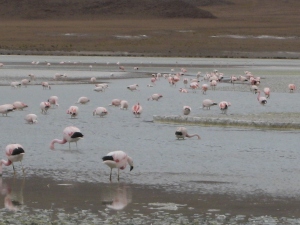
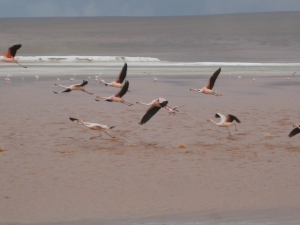
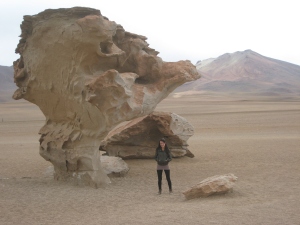
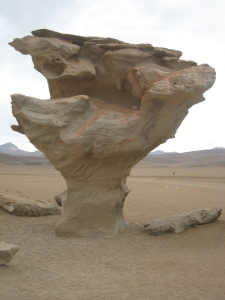
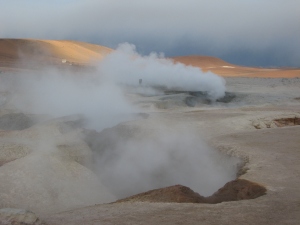

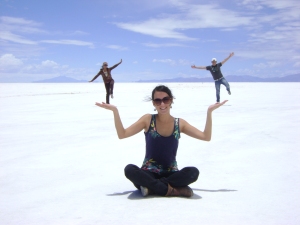
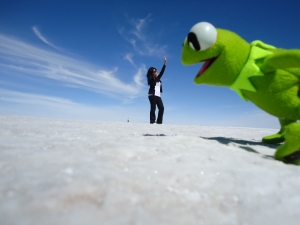
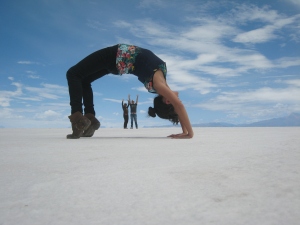
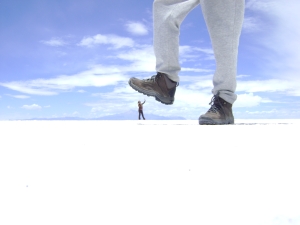
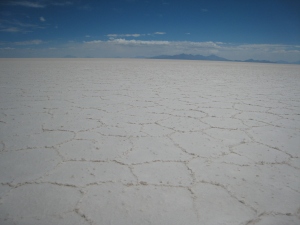
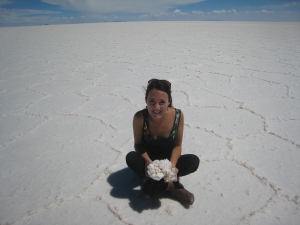
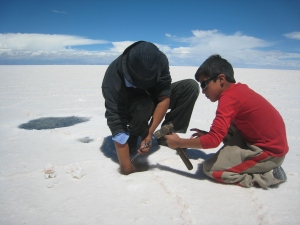
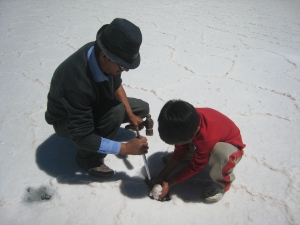
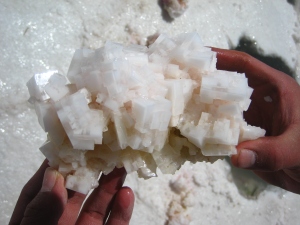
One small step for womankind…
Love all the pics, hate all the danger!
Ha, thanks Julie!
Your dad says he’s coming to Bolivia!! I am equally tempted…
🙂
Joni – congratulations on a stunning piece of reportage. I have read about the salt flats and we recently saw them on UK TV but your piece is much more enlightening and the stills are stunning. I am a proud spectator!
Very kind, thanks dad. x
Never knew you could do the backward arch (I think that’s what you call that pose!). Is that Kermit really there or been digitally manipulated? Wonderful photos, Joni.
I can`t, I`m digitally manipulated. (Also, did you notice how small my friends are? I told you I`m tall in Bolivia.)
First and foremost, I’m honoured that you chose to wear the top I gave you for your unforgettable obligatory Salar perspective shots! You look lovely and your photos are equally beautiful. Brings back happy memories of my visit there. The scenery is just spectacular. You describe it so well. I’ve been on a run of working weekends but Skypemos soon. Hope your presentation went well. un besazo
Ah, thanks Bmoon. ¡Qué amable eres! I loved your blog post about the Salar too (`inhospitable` terrain, jaja). You`re gifted at picking gifts I love (another features in my `about` pic). x P.S. Presentation went ok – nerves akin to 2002 Sp oral but luckily a better outcome, i.e. no hysterical lágrimas.
PS Cochabambino is my favourite demonym…and that’s saying something 😉
Demonym, aha. Love it! I actually wondered what the official word was for the name of locals, and ought to have known you could supply me with the correct term. 🙂 And yes, it is the best.